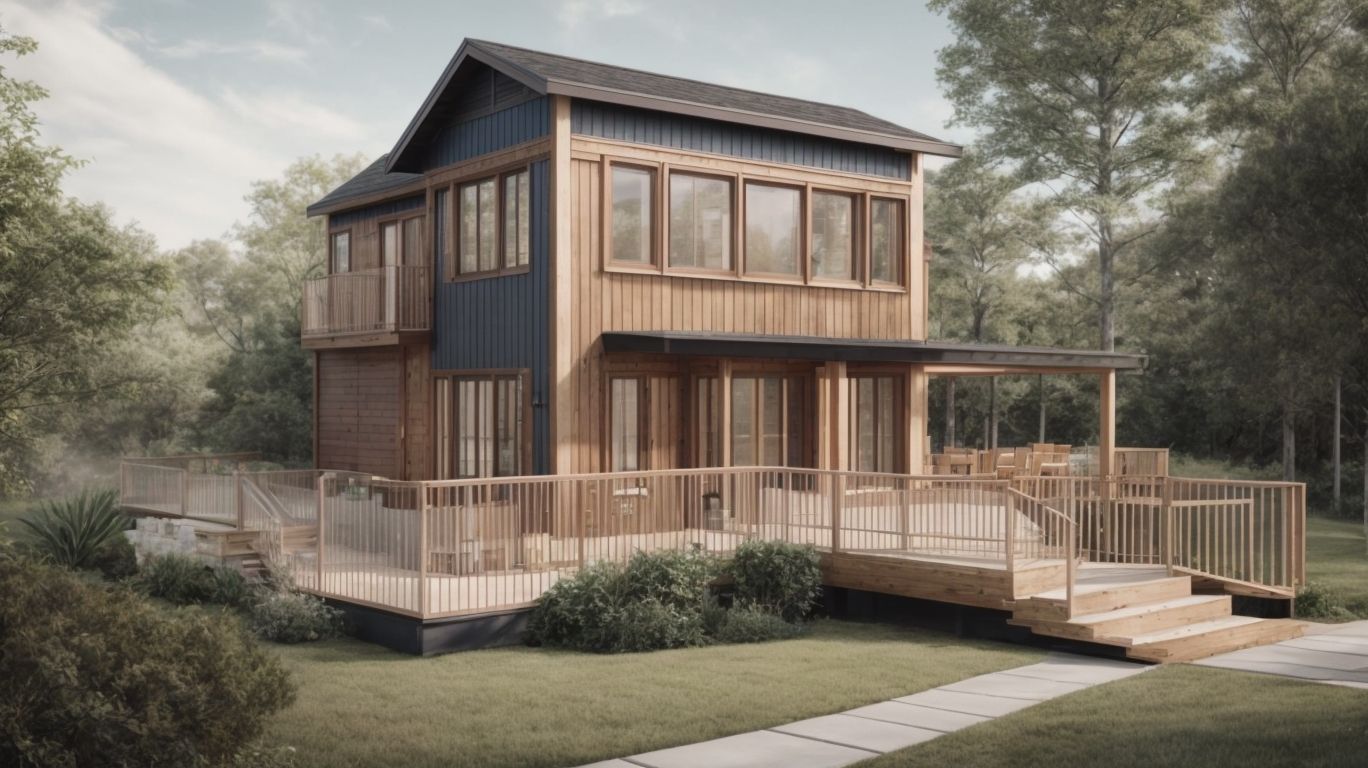
Mastering the Permit Process for Your Bay Area Second Story Addition
Considering a second story addition for your home in the Bay Area? Navigating the permit process is crucial for a smooth and successful construction project. Researching local building codes and addressing neighbors’ concerns are essential steps in obtaining the necessary permits.
In this article, we will explore why permits are necessary, the steps in the permit process, common challenges you may face, and how to expedite the process.
Master the permit process for your Bay Area second story addition by staying tuned!
What Is a Second Story Addition?
A second story addition involves expanding a residential property vertically by constructing an additional level above the existing structure, offering more living space and enhancing the property’s value amidst dynamic trends in the housing market and construction industry.
This renovation strategy is gaining popularity as homeowners seek to maximize their living space without compromising on yard space. By adding a second story, property owners can create more bedrooms, bathrooms, or even a new recreational area, providing flexibility for changing needs and preferences.
From a property development perspective, a second story addition can significantly increase the resale value of a home, making it a wise investment in a competitive real estate market. Design considerations such as matching architectural styles, structural integrity, and seamless integration with the existing layout are crucial aspects to ensure a successful and harmonious second story addition.
Why Do You Need a Permit for a Second Story Addition?
Obtaining a permit for a second-story addition is essential to comply with legal requirements and ensure that the construction adheres to building codes, safeguarding structural integrity and meeting zoning regulations in the Bay Area.
It is crucial to understand that permits serve as official authorization, validating that the proposed structural changes meet the established building standards. Without these permits, homeowners risk facing fines, project delays, or even having to dismantle the additions. By obtaining the necessary permit documentation, individuals can demonstrate that their second-story additions have been inspected and approved by authorities, ensuring safety for occupants and protecting the overall value of the property.
What Are the Steps in the Permit Process for a Second Story Addition?
The permit process for a second story addition involves multiple steps, including researching local building codes, creating detailed plans, submitting the permit application, paying fees, and scheduling inspections, all crucial elements in managing the construction timeline and budget effectively.
Understanding the permit processing time is crucial as it varies depending on the complexity of the project and the workload of the permitting department.
The application review phase typically involves ensuring compliance with zoning regulations and structural requirements. After approval, permit issuance requires payment of permit fees, which can range from a flat rate to a percentage of the project cost. Effectively managing these costs is essential for staying within budget. Once construction begins, timely inspection scheduling is vital to ensure compliance with regulations and avoid delays in project completion.
Research Local Building Codes and Zoning Regulations
Before beginning a second story addition project, thorough research on local building codes and zoning regulations is imperative to ensure compliance with standards set by the Building Permits Department, promoting urban development and prioritizing construction safety.
Adhering to building codes and zoning regulations not only guarantees the structural integrity of the project but also plays a crucial role in sustainable urban planning.
By understanding and following these regulations, builders contribute to minimizing the environmental impact of construction activities. Compliance with zoning ordinances ensures that new structures fit harmoniously within the existing urban landscape, fostering a cohesive and aesthetically pleasing cityscape. Attention to construction materials specified in building codes further enhances the safety and longevity of the built environment, creating resilient and durable structures.
Create Detailed Plans and Blueprints
The next step after researching regulations is to develop detailed architectural plans and blueprints that align with residential design standards, outlining the scope of the building expansion and ensuring structural integrity and aesthetic appeal.
- This process involves collaborating with architects and structural engineers to create a comprehensive design that factors in considerations like site topography, existing building structure, and zoning requirements.
- The plans must also incorporate elements such as room layout, window placements, roof design, and material specifications to achieve a cohesive and functional second-story addition.
- Specific attention is paid to integrating sustainable practices and energy-efficient features into the design, ensuring compliance with building codes and obtaining necessary permits for construction.
Submit Your Permit Application
Once the plans are finalized, submitting a comprehensive permit application becomes essential, undergoing review processes to ensure compliance with regulations, and submitting all necessary construction documents for permit approval.
During the review procedures, it is crucial for the applicant to provide detailed information about the proposed second story addition, complying with local permit restrictions and building codes. The documentation required often includes architectural drawings, structural plans, site plans, and sometimes even environmental impact assessments. Adhering to these permit guidelines not only expedites the approval process but also ensures that the construction meets all necessary standards for safety and aesthetic integrity.
Pay Permit Fees
Subsequent to application submission, payment of permit fees is a crucial step in the process, considering budgeting aspects and aligning with housing permit application requirements to cover necessary construction fees for the second story addition.
This financial aspect plays a vital role in ensuring that the construction project runs smoothly and within the allocated budget. By paying the permit fees promptly, homeowners can avoid delays in the approval process and adhere to legal regulations. Understanding the breakdown of construction costs included in the permit fees can aid in better budget management. It is essential to carefully review the permit application specifics to accurately estimate the overall expense and streamline the construction timeline.
Schedule Inspections
Once the fees are settled, scheduling inspections is vital to ensure compliance with building inspection requirements, overseeing construction management aspects, and verifying adherence to housing code standards throughout the project.
This process typically involves coordinating with the construction crew to determine the optimal timing for inspections at key project milestones. Building permits need to be displayed prominently on-site, as these documents serve as a visual cue to the inspectors and demonstrate regulatory compliance.
A thorough understanding of housing policy regulations is crucial for the construction team to address any potential issues that may arise during the inspection process, ensuring that the second-story addition meets all necessary standards for safety and quality.
What Are the Common Challenges in the Permit Process for a Second Story Addition?
Navigating the permit process for a second story addition can present challenges, such as avoiding building codes violations, managing renovation costs effectively, and mitigating construction risks associated with the project.
One common challenge many homeowners face is ensuring that the construction materials used in the renovation project meet the stringent requirements set by local building codes. This often involves detailed inspections and approvals, which can cause delays and additional expenses.
Accurately estimating renovation costs at the outset is crucial to prevent budget overruns. Factors like unforeseen structural issues or unexpected permit fees can quickly escalate expenses, requiring careful planning and constant monitoring. Construction risks, such as inclement weather or contractor availability, may impact project timelines and overall success.
Meeting Building Code Requirements
Ensuring compliance with stringent building code requirements is a primary challenge in the permit process, necessitating alignment with housing permit regulations and potential consultation with permit consultants for guidance.
Navigating the maze of city permits and ensuring permit compliance for a second-story addition can be a time-consuming and intricate process. Permit processing times vary greatly depending on the city and can sometimes lead to delays in construction projects. Permit consultants play a crucial role in this process, providing expertise on building standards and helping to streamline the permit application process. Their guidance can be invaluable in ensuring that the project meets all necessary requirements and moves forward smoothly within the legal framework.
Obtaining Necessary Permits and Approvals
Securing the required permits and approvals amidst city regulations and housing laws can be a complex challenge, especially when incorporating structural changes that demand meticulous compliance with legal requirements.
Navigating through the process of obtaining permits for a second-story addition involves a myriad of obstacles. City regulations often dictate specific criteria for building heights, setbacks, and overall appearance, all of which must be adhered to when planning an expansion. Housing laws may stipulate occupancy limits, fire safety measures, and accessibility standards that need to be considered. Structural changes, such as adding a second story, require thorough review and approval to ensure they meet safety codes and won’t compromise the integrity of the existing structure. These factors underscore the importance of detailed planning and adherence to permit restrictions to avoid delays and legal complications.
Addressing Neighbors’ Concerns
Managing and addressing neighbors’ concerns during the permit process is vital to fostering positive relationships within the neighborhood, aligning with the required steps in the permit process and promoting energy-efficient design solutions.
Understanding the dynamics of the neighborhood and actively involving nearby residents in the project can help build trust and ease any apprehensions. Communication plays a key role in addressing concerns, ensuring that everyone feels heard and considered. Incorporating energy-efficient strategies not only benefits the homeowner but also contributes to the overall sustainability of the community. By being mindful of housing market trends and the environmental impact of construction, a second-story addition can be a successful endeavor that enhances both the property value and the neighborhood aesthetics.
How Can You Expedite the Permit Process for a Second Story Addition?
To streamline the permit process for a second story addition, efficient project management, stringent compliance with regulations, and prompt acquisition of the building permit are essential steps to expedite approval and commence construction swiftly.
When it comes to project management, having a detailed schedule with clear milestones and responsibilities can significantly speed up the permit process. This helps ensure that all tasks are completed in a timely manner, preventing any delays in obtaining the necessary approvals.
In addition, adhering strictly to construction guidelines and codes from the beginning of the project can prevent costly revisions and re-submissions. Utilizing high-quality construction materials that meet regulatory standards can also help expedite permit approval, as inspectors will be more likely to approve plans that adhere to safety and quality requirements.
Hire a Reputable Contractor or Architect
Engaging a reputable contractor or architect is a proactive step to expedite the permit process, ensuring adherence to housing policy guidelines and facilitating a seamless building process for the second story addition project.
These professionals bring valuable expertise in navigating complex construction regulations and handling housing permit applications efficiently. By leveraging their knowledge and experience, the permit processing time can be significantly reduced, saving time and avoiding potential delays. Their familiarity with local building codes and regulations helps in meeting all necessary requirements, ensuring that the project progresses smoothly without any legal setbacks. Their attention to detail enhances the overall quality of work and compliance with safety standards, providing peace of mind to the homeowner throughout the construction journey.
Have All Necessary Documents and Information Ready
Preparedness in having all essential documents and information readily available expedites the permit process, ensuring permit compliance, facilitating building inspection procedures, and aligning with the current dynamics of the real estate market.
By being organized and proactive in gathering necessary permits and documents, individuals and construction firms can stay ahead of potential delays and smoothly navigate the regulatory landscape.
Keeping abreast of the latest trends in the real estate market can also provide valuable insights into optimal construction strategies and potential risks.
Timely preparation not only expedites the permit process but also demonstrates a commitment to safety, quality, and sustainability that can enhance project credibility and appeal to investors and stakeholders.
Communicate Effectively with Permitting Authorities
Establishing clear and effective communication channels with permitting authorities is crucial in expediting the permit process, facilitating a streamlined renovation process, and addressing permit procedures promptly for successful home remodeling endeavors.
It is imperative to maintain open lines of communication to navigate through the complexities of permit reviews and address any construction challenges efficiently. By staying in constant contact with the relevant authorities and adhering to city regulations, homeowners can ensure a smoother renovation journey. Effective communication not only expedites the permit approval process but also allows for better coordination with contractors and suppliers, leading to a more effective implementation of home remodeling strategies.
Be Proactive in Addressing Any Issues or Objections
Proactively addressing potential issues or objections that arise during the permit process is key to maintaining efficient construction timeline management, ensuring successful home building ventures, and upholding permit compliance standards for the second story addition.
By anticipating and resolving construction risks early on, builders can navigate the intricate web of building codes compliance with greater ease. This proactive approach not only streamlines the permit procedures but also minimizes delays that could jeopardize the project timeline. Integrating thorough risk assessment into the planning phase allows for effective problem-solving strategies, ensuring that any permit-related challenges are met with strategic solutions. Successful permit management involves a balance of foresight and adaptability to unexpected obstacles, ultimately contributing to the overall success of the construction endeavor.




No Comments